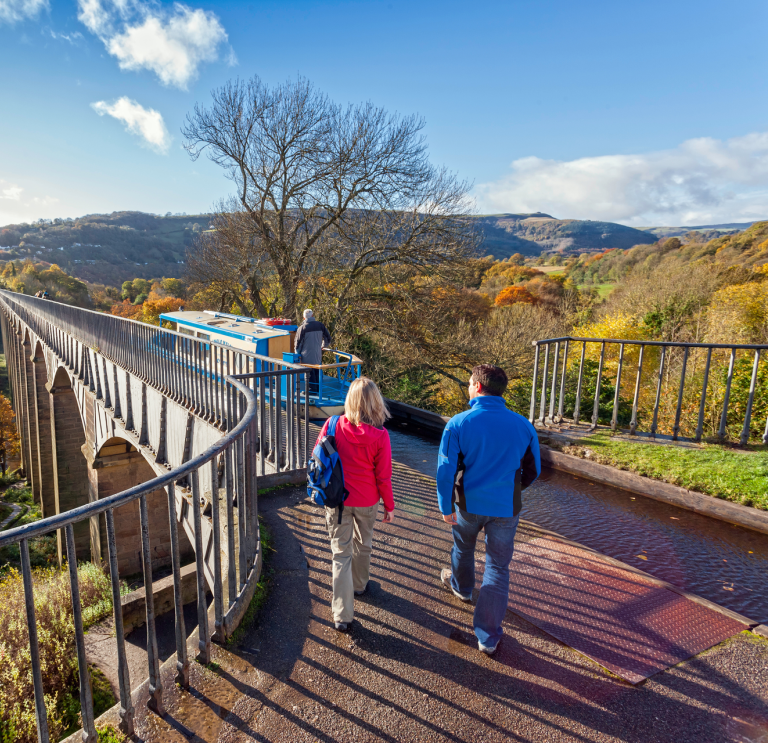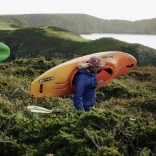The River Wye
The River Wye was voted Britain’s favourite river thanks to its stunning scenery and abundant wildlife, with features of interest for everyone. As the Wye and Usk Foundation will tell you, it’s for: ‘rowers, canoeists, anglers, walkers, nature lovers and anyone with an eye for scenic beauty’.
Explore the Wye Valley with a relaxing canoe or kayak trip. Hire a Canadian canoe, or a single or double kayak for a few hours or even up to a few days. Half a day will take you to Hay-on-Wye, the second-hand bookshop capital of the world and a fantastic place to potter around for an afternoon; a longer spell will take you to pretty Monmouth, where you can stay overnight.

The River Teifi
The Teifi is one of Wales’ longest rivers at 73 miles, running along the boundary between Carmarthenshire and Ceredigion for most of its length, and Ceredigion and Pembrokeshire for its final three miles. Not just long and beautiful, the Teifi is an adventure playground for kayaking, canoeing, coasteering and river-swimming.
Llandysul Paddlers organises all of the above, as well as an annual river festival in the summer and the ‘Teifi Tour’ – a weekend of paddling and partying – in the autumn. The Teifi also is where one of the most spectacular wildlife events of the year happens each autumn: the salmon leap. Head to Cenarth Falls to see it and pop into the National Coracle Centre while you’re there to learn about the rather romantic-sounding tradition of coracle fishing: heading out in a round-bottomed boat at night (only once seven stars have appeared in the sky, mind) to fish for salmon and sewin, a local speciality.

The River Tywi (and the Cennen!)
The Tywi is Wales’ longest river at 75 miles and takes in some of the country’s most stunning attractions, winding through the National Botanic Garden of Wales, gorgeous Aberglasney Gardens and Dinefwr Park, where you can combine a visit to 12th century castle ruins with heron-spotting along the river.
The river then winds its way northwards and through what is now the Gwenffrwd Dinas RSPB Nature Reserve. An attractive three-mile walk along the river leads to the steep caves where the ‘Welsh Robin Hood’, Twm Siôn Cati, used to hide from his arch-nemesis, the Sheriff of Carmarthen! Go in late spring, when the woodlands are a carpet of bluebells. Meanwhile, a few miles south of Dinefwr, in the Bannau Brycheiniog (Brecon Beacons) National Park, is Trapp, the starting point for two walks that involve crossing the River Cennen, seeing soaring red kites above you and taking in marvellous Carreg Cennen Castle, which perches on a crag over the water.


The Pontcysyllte Aqueduct and River Dee
The Pontcysyllte Aqueduct is many things: the oldest and longest navigable aqueduct in Britain; the highest aqueduct in the world; a Grade I listed building; a UNESCO World Heritage Site. It’s also a fantastic visitor attraction. Carrying the Llangollen Canal over the River Dee, the 18-arched structure was designed and built by Thomas Telford and William Jessop, and it’s one of the most remarkable achievements of the industrial revolution.
You can walk along it, though the heights are pretty knee-trembling, so you may prefer to take a boat ride, or even hire your own boat. For another special canal experience, head to Llangollen Wharf and take a horse-drawn boat trip along the feeder for the main canal. If all this sounds too leisurely, embark on a white water rafting experience down the River Dee; Whitewater Active is one of a number of operators organising exciting rafting days out, where you’ll speed over Grade 2/3 rapids with highlights including the ‘Serpent’s Tail’.


Monmouthshire & Brecon Canal
One of the most serene stretches of water in Wales, the Monmouthshire & Brecon Canal - or ‘Mon and Brec’ – is an isolated waterway that meanders through the Bannau Brycheiniog (Brecon Beacons) National Park. Take a bike ride or boat trip along the canal from Brecon, or simply walk along it and stop at one of the many canal-side pubs for lunch.
The waterway passes by the UNESCO World Heritage site at Blaenavon – which includes the Big Pit National Coal Museum – as well as the charming market towns of Crickhowell and Abergavenny; the latter is home to a famous food festival in the autumn and is the perfect place to pick up a picnic.


Following the tranquil Usk Valley, the Monmouthshire & Brecon Canal is a haven for wildlife where you can spot buzzards, red kites, herons and darting dragonflies."
Llyn Tegid
The largest natural lake in Wales is Llyn Tegid in Bala. It’s over three and a half miles long, three quarters of a mile wide and over 140 feet deep in places – perhaps it’s at the bottom that ‘Teggie’ is hiding..? Teggie is Wales’ answer to the Loch Ness Monster, a mysterious creature, ‘sightings’ of which date back to the 1920s. While Teggie may be the stuff of legend, Llyn Tegid is home to a prehistoric fish, the Gwyniad, that has survived here since the Ice Age; the fish only appear at the lake’s surface in the winter months when they come to spawn.
Today, the lake is popular among sailors, canoeists and even windsurfers. Close to the lake are more aquatic attractions, including Pistyll Rhaeadr, Wales’ highest waterfall, Lake Vyrnwy (see below) and the River Tryweryn, home to the National Whitewater Centre – the water levels here are dam-controlled, so the rapids still thunder forth in the summer months.

Lake Vyrnwy
Lake Vyrnwy is, in fact, a reservoir, created in the 1880s to supply Liverpool with a fresh supply of water. The site chosen for the reservoir housed a small village, Llanwddyn, which was submerged (don’t worry, it was evacuated first!); as you gaze over the unblemished surface of the water, it’s incredible to think of the houses, post office and parish church that lie beneath.
It’s also hard to believe it was man-made; the five-mile long stretch is surrounded by stunning mountain scenery that shelters an abundance of wildlife – the lake and estate are jointly managed by the RSPB and Severn Trent Water. Bird-watchers and nature-lovers flock to Lake Vyrnwy, where you can enjoy a gentle 12-mile cycle around the water as well as numerous picturesque walks. It’s also a magnet for luxury-seekers, who stay at the Lake Vyrnwy Hotel and Spa. Even if you don’t stay, book a table with a view at the Tower Restaurant and enjoy fantastic food with a side of stunning scenery.

Llyn y Fan Fach
The road to reach Llyn y Fan Fach may be bumpy, and the walk up to the ridge slightly steep, but what a view over this magnificent body of water, overlooked by the majestic Black Mountain, once you reach the summit of Picws Du in the Bannau Brycheiniog (Brecon Beacons) National Park.
The glacial lake is the subject of a myth told in the medieval Mabinogion collection. An enchanted lady is said to have arisen from the lake and gone on to marry a local farmer, only for their marriage to be thwarted by magic and misunderstanding. The heroine fled back to her lake and the farmer had to bring up his three sons alone; the trio went on to become great healers known today as the Physicians of Myddfai. Have a picnic by Llyn y Fan Fach - keeping your eyes peeled for the enchantress that dwells within...
Llyn Ogwen
If you’ve already scaled Eryri's (Snowdonia’s) peaks and fancy giving your thighs a rest, head on a circular walk of Llyn Ogwen, with amazing views of Tryfan and the Glyderau mountains – and no hills to climb! The ribbon lake is a mile long and has a depth of just three metres, so it should be easy for the avid legend-hunter to locate ‘Excalibur’, King Arthur’s famed sword (known as ‘Caledfwlch’ in Welsh), as many claim Llyn Ogwen is the final resting place of the sword…

Llyn Llydaw
…Or does Excalibur lie at the bottom of Llyn Llydaw?! Close to Ogwen and on the flanks of Yr Wyddfa (Snowdon), Llyn Llydaw is another contender for the weapon’s watery home. The Miner's Track that leads up to Yr Wyddfa (Snowdon) passes the lake, with spectacular views over it as you ascend.





